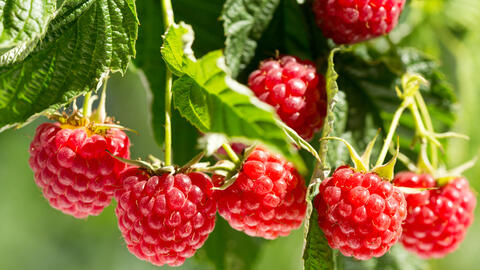Caring for your Raspberry plant: The 3 Most Common Mistakes
You can make mistakes while caring for your Raspberry plant. If you avoid these three mistakes, you’ll have a bountiful harvest of the delicious fruits.

Raspberries are popular snacking fruit
Fruity-sweet, tasty and full of vitamins: Raspberries are tempting as a snacking fruit and are easy to care for. If you avoid these mistakes in raspberry care, nothing stands in the way of an abundant harvest.
Raspberry care begins with the location. Because raspberries don't like growing on unsuitable soil. They love loose, deep and above all humus-rich soils. The soil can be slightly acidic with pH values between 5.5 and 6. On the other hand, raspberries hate very loamy or waterlogged soil, where they can easily catch fungal diseases on roots and shoots.

But you can plant raspberries even if you have clayey soil. When planting, enrich the soil with 1:1 ratio of mature compost and add to it good portion of coarse sand if possible. Raspberries ideally grow in rows and with climbing aids made of stretched wire.
Mulch not only helps in the shrub bed, but also take care of the raspberry plant. As original forest dwellers, raspberries love a loose layer of mulch on the surface of the soil. The mulch layer, several inches thick, made of slightly dried grass clippings, mulch soil or straw simulates the natural fallen leaf cover in the forest. Straw or coarse bark mulch must be scattered after mixing it with horn shavings in order to enrich the soil with sufficient nitrogen and to prevent any deficiencies.

Things that you do to take care of raspberries also helps the soil organisms: Mulch acts like a parasol, keeping the soil moist and the soil fauna in good health. This works out well, because raspberries have very shallow roots; deep and water-rich layers of soil are inaccessible to them. Mulch does not prevent annoying weeds, however, seeds that settle on the soil can germinate and mulch is not a serious barrier for root weeds. However, you can easily pull freshly germinated weeds and young plants out of the loose mulch material.
Not pruning the Raspberry plant and just leting it grow wildly, is one of the biggest mistakes. There are two variants: Summer Raspberries and Fall Raspberries. Care is largely the same for both, the varieties only differ in their harvest time and pruning time.
Summer Raspberries bear on the previous year’s shoots, also bear on the new branches. Both variants form a whole batch of new shoots each year that grow directly from the plant base. In case of summer raspberries, only leave six to eight branches per plant; the rest will come off and cut close to the ground. Important: Do not cut off two-year-old shoots on the plant, otherwise the harvest will fail the next year. In the case of fall raspberries, on the other hand, the cut is a little rougher, you can cut all the shoots close to the ground. The right time to prune is after the harvest, i.e. from the end of July for Summer Raspberries and on mild winter days for fall Raspberries.
You will have to frequently deal with if you have a Raspberry plant, which makes the juicy fruits maggoty and lays its eggs in the flowers. The hatched maggots then eat their way through the fruit and make it unsavory. Experience has shown that it is best to plant the fall Raspberry plant where the beetles tend to flourish, because these plants are insensitive. When they bloom from mid-July, the beetle has long been through with its family planning and will no longer attack the flowers.





